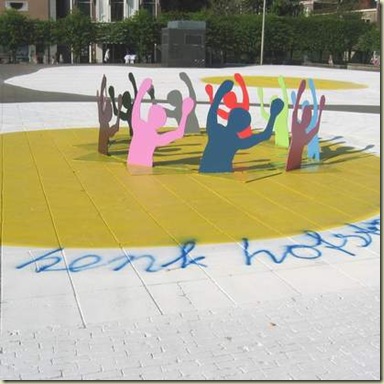 The Pont du Gard is a three-level stone aqueduct crossing the Gardon river valley, about 25 km west of Avignon. Built shortly before the Christian era, in 19 BC, by Marcus Vipsanius Agrippa, the son-in-law of Augustus.
The Pont du Gard is a three-level stone aqueduct crossing the Gardon river valley, about 25 km west of Avignon. Built shortly before the Christian era, in 19 BC, by Marcus Vipsanius Agrippa, the son-in-law of Augustus.
The Pont du Gard was added to UNESCO's list of UNESCO World Heritage Sites in 1985.
Designed to carry the water across the small Gardon river valley, it  was part of a nearly 50 km (31 mi) aqueduct that brought water from springs near Uzès to the Roman city of Nemausus (Nîmes). This bridge is 275 metres (900 feet) long and 49 metres (160 feet) high. The full aqueduct had a gradient of 34 cm/km (0.4 per cent), descending only 17 m vertically in its entire length and delivering 20,000 cubic meters (44 million gallons) of water daily.
was part of a nearly 50 km (31 mi) aqueduct that brought water from springs near Uzès to the Roman city of Nemausus (Nîmes). This bridge is 275 metres (900 feet) long and 49 metres (160 feet) high. The full aqueduct had a gradient of 34 cm/km (0.4 per cent), descending only 17 m vertically in its entire length and delivering 20,000 cubic meters (44 million gallons) of water daily.
The three levels were built in dressed stone without the use of mortar. The aqueduct's stones - some of which weigh up to 6 tons - are held together with iron clamps. The masonry was lifted into place by block and tackle with a massive human-powered treadmill providing the power for the winch.  A complex scaffold was erected to support the aqueduct as it was being built. The face of the aqueduct still bears the mark of its construction, in the form of protruding scaffolding supports and ridges on the piers which supported the semicircular wooden frames on which the arches were constructed. It is believed to have taken about three years to build, employing between 800 and 1,000 workers.
A complex scaffold was erected to support the aqueduct as it was being built. The face of the aqueduct still bears the mark of its construction, in the form of protruding scaffolding supports and ridges on the piers which supported the semicircular wooden frames on which the arches were constructed. It is believed to have taken about three years to build, employing between 800 and 1,000 workers.
In 1998 the Pont du Gard was hit by major flooding which caused widespread damage in the area. The road leading up to it and the neighboring facilities were badly damaged, although the aqueduct itself was not seriously harmed.
The French Government sponsored a major redevelopment project in conjunction with local sources, UNESCO and the EU which concluded in 2000, pedestrianising the entire area around the aqueduct and greatly improving the visitor facilities, including establishing a museum on the north bank. The project has been criticized for its cost (€32 million) and for the perceived loss of natural beauty of the surrounding landscape and area. One side-effect is that it is no longer possible to walk through the conduit at the top of the aqueduct. However, the redevelopment has ensured that the area around the Pont du Gard is now much quieter due to the removal of vehicle traffic, and the new museum provides a much improved historical context for visitors.
sources wikipedia, greatbuildings.com
Read more: John Julius Norwich, ed. Great Architecture of the World.
Kevin Matthews. The Great Buildings Collection on CD-ROM.














